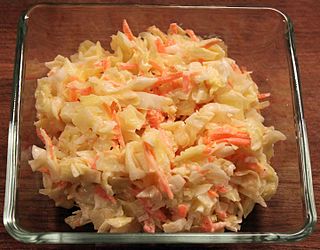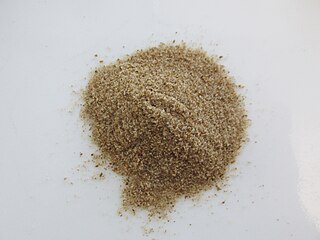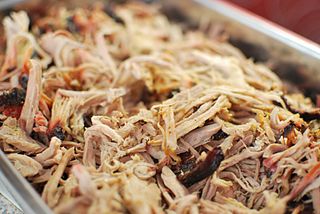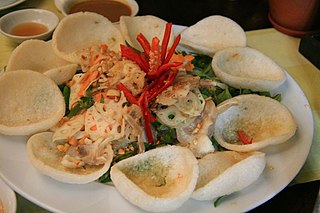
A salad is a dish consisting of mixed ingredients, frequently vegetables. They are typically served chilled or at room temperature, though some can be served warm. Condiments and salad dressings, which exist in a variety of flavors, are often used to enhance a salad.

Coleslaw, also known as cole slaw, or simply as slaw, is a side dish consisting primarily of finely shredded raw cabbage with a salad dressing or condiment, commonly either vinaigrette or mayonnaise. This dish originated in the Netherlands in the 18th century. Coleslaw prepared with vinaigrette may benefit from the long lifespan granted by pickling.

Canadian cuisine consists of the cooking traditions and practices of Canada, with regional variances around the country. First Nations and Inuit have practiced their culinary traditions in what is now Canada since at least 15,000 years ago. The advent of European explorers and settlers, first on the east coast and then throughout the wider territories of New France, British North America and Canada, saw the melding of foreign recipes, cooking techniques, and ingredients with indigenous flora and fauna. Modern Canadian cuisine has maintained this dedication to local ingredients and terroir, as exemplified in the naming of specific ingredients based on their locale, such as Malpeque oysters or Alberta beef. Accordingly, Canadian cuisine privileges the quality of ingredients and regionality, and may be broadly defined as a national tradition of "creole" culinary practices, based on the complex multicultural and geographically diverse nature of both historical and contemporary Canadian society.

Macaroni salad is a type of pasta salad, served cold, made with cooked elbow macaroni and usually prepared with mayonnaise. Much like potato salad or coleslaw in its use, it is often served as a side dish to barbecue, fried chicken, or other picnic style dishes. Like any dish, national and regional variations abound but generally it is prepared with raw diced onions, dill or sweet pickles and celery and seasoned with salt and pepper.

Celery salt is a seasoned salt used to flavour food. The primary ingredient is table salt and the flavouring agent is ground seeds from celery or its relative lovage. It is also sometimes produced using dried celery or seed oleoresin.

Chinese chicken salad is a salad including chopped chicken and Chinese culinary ingredients that is common in parts of the United States. Though many variations exist, common features of Chinese chicken salads include lettuce, cabbage, carrots, cucumbers, chicken, deep-fried wonton skins or rice vermicelli and nuts. A basic vinaigrette for the salad includes ingredients like vegetable oil, sesame oil, rice vinegar. Optional seasonings include dry hot mustard, sesame seeds, coriander and raw ginger or pickled ginger. In restaurants, Chinese chicken salad may be more embellished and offered as an American-style entree salad, similar to Caesar, Chef, and Cobb salads.

Cheese slaw is a salad and side dish consisting of cheddar cheese, carrot, mayonnaise, and sometimes cabbage. Other cheeses such as blue and Swiss are occasionally used in its preparation, and additional vegetable ingredients are sometimes used. Its origins can be traced to Townsville in north Queensland, Australia, and to Broken Hill, New South Wales, Australia. It is a common and popular dish in Broken Hill restaurants and households. Cheese slaw is also consumed in some areas of the United States.

Seven-layer salad is an American dish that includes a colorful combination of seven layers of ingredients: iceberg lettuce, tomatoes, cucumbers, onions, sweet peas, hard-boiled eggs, sharp cheddar cheese, and bacon pieces. The salad is topped with a mayonnaise-based dressing and sometimes sour cream is added. It is often served in a glass bowl or large pan so the layers can be observed. The dish is often associated with potlucks, picnics, and barbecues, where a large gathering of people takes place and many people need to be fed. There are many variants of the seven-layer salad and it can be made with additional layers, making it an eight-layer salad instead.
The second season of the American reality competition show Top Chef Masters was announced on October 22, 2009. In addition, it was announced that Gail Simmons would be added as a critic. The season premiered on April 7, 2010 with 22 chefs competing against each other in weekly challenges. In the season finale that premiered on June 9, 2010, Marcus Samuelsson was crowned Top Chef Master.
The seventh season of the renamed American reality television series Food Network Star premiered Sunday, June 5, 2011. Food Network executives, Bob Tuschman and Susie Fogelson, are joined again by Bobby Flay and Giada De Laurentiis as the judges for this season. The series was filmed in Los Angeles, California and New York, New York.

Heinz Sandwich Spread is a blend of salad cream and relish manufactured by Heinz and popular in the Netherlands and Britain. It is classified by the manufacturer as a sauce or relish. The relish ingredients are Spirit Vinegar, Sugar, Cabbage, Rapeseed Oil, Water, Carrots, Gherkins, Modified Cornflour, Salt, Onions, Egg Yolks, Red Peppers, Mustard, Stabilisers - Guar Gum and Xanthan Gum, Spice Extracts, Spices, Herb Extract, Flavourings, Colour - Riboflavin, VEGETABLES 35%. The salad cream base results in a more tart flavour than similar mayonnaise-based sandwich spreads found in the United States.

Barbecue is an important part of the heritage and history of the U.S. state of North Carolina. It has resulted in a series of bills and laws that relate to the subject, and at times has been a politically charged subject. In part, this is due to the existence of two distinct types of barbecue that have developed over the last few hundred years: Lexington style and Eastern style. Both are pork-based barbecues but differ in the cuts of pork used and the sauces they are served with. In addition to the two native varieties, other styles of barbecue can be found throughout the state.

Red slaw is a condiment commonly served on hot dogs, on barbecue pork sandwiches, as a side dish for other types of barbecue, on hamburgers, or with other foods. It is an essential part of "Lexington style" North Carolina barbecue.

Nộm or Gỏi is the indigenous salad of Vietnamese cuisine. It is to be distinguished from sa lát, and sa lát Nga found in Western style restaurants.

A barbecue sandwich is a sandwich that is typically prepared with barbecued meats. Several types of meats are used to prepare barbecue sandwiches. Some varieties use cooked meats that are not barbecued, but include barbecue sauce. Many variations, including regional variations, exist, along with diverse types of cooking styles, preparations and ingredients.

A cold plate is a popular dish with origins in rural Newfoundland, Canada.
Boiled dressing is a type of creamy salad dressing of English and German origin that was especially popular in the 19th century and early 20th century as an alternative to mayonnaise, which is of French origin. Boiled dressing is easier for less skilled cooks to make from scratch, and liquid food oils needed to make mayonnaise were not readily available in Northern Europe and the United States in the 19th century. Mayonnaise was not available for retail purchase until 1912.














